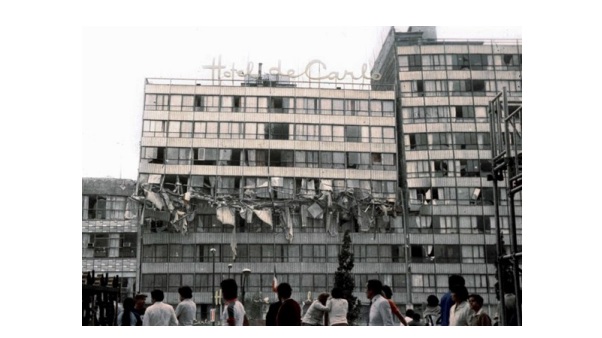GOLPETEO ESTRUCTURAL EN LA VULNERABILIDAD SÍSMICA DE EDIFICIOS UBICADOS EN SUELOS BLANDOS
Keywords:
Seismic vulnerability, Structural pounding, Incremental Dynamic Analysis, Soft soilsAbstract
Este trabajo se enfoca en determinar el efecto que tiene el fenómeno del golpeteo estructural sobre la respuesta dinámica no lineal de edificios, ubicados en la zona de suelo blando de la Ciudad de México; cuando están sujetos a acciones sísmicas. Para ello, se identificarán las tipologías estructurales a analizar, cuyo comportamiento se evaluará a través de análisis dinámicos incrementales, i.e. análisis no lineales paso a paso con incremento monotónico de la demanda sísmica. Este análisis se llevará a cabo empleando el software Opensees; el comportamiento no lineal por desplazamientos laterales se modelará a través de plasticidad concentrada en los elementos estructurales a partir de sus respectivos diagramas momento-curvatura y momento-rotación. Para modelar el fenómeno de golpeteo se empleará un modelo de fuerza de contacto durante la colisión entre estructuras, suponiendo que el contacto se genera entre los sistemas de piso de las estructuras colindantes. Este modelo podrá ser el viscoelástico lineal o el elástico no lineal de Hertz, dependiendo cuál represente mejor las condiciones de las estructuras.
Mediante el análisis realizado, se espera determinar que el golpeteo estructural afecta de manera importante las estructuras, ya que provoca una amplificación en la respuesta sísmica del edificio y, como consecuencia, un aumento en el cortante de entrepiso, lo cual puede inducir el colapso de la estructura. La información obtenida en este trabajo será de utilidad para determinar la vulnerabilidad estructural sísmica para el fenómeno de golpeteo estructural y, de ser posible, tomar las acciones preventivas pertinentes para la mitigación del riesgo.
Downloads
References
Anagnostopoulos, S. A. (1988). “Pounding of buildings in series during earthquakes”, Earthquake Engineering and Structural Dynamics, 16, pp. 443–456.
Anagnostopoulos, S., Spiliopoulos, K. (1992) “An investigation of earthquake induced pounding
between adjacent buildings”, Earthquake Engineering and Structural Dynamics, 21, pp. 289–302.
Almaraz, S. (2019) “Comportamiento sísmico de marcos de concreto reforzado con piso débil ante acciones de eventos de subducción y falla normal”, Tesis licenciatura, Facultad de Ingeniería, UNAM.
Cole, G., Dhakal, R., Carr, A. y Bull, D. (2010) “Building pounding state of the art: Identifying structures vulnerable to pounding damage”, 2010 NZSEE Conference.
Goland, M., Wickersham, P. y Dengler, M. (1955) “Propagation of elastic impact in beams in bending”, Journal of Applied Mechanics, 22, pp. 1-7.
Goldsmith, W. (1960) “The Theory and Physical Behavior of Colliding Solides”, Arnold, London, UK.
Hosseini, S., Naderpur, H., Vahdani, R. y Jankowski, R. (2021) “Evaluation of pounding effects between reinforced concrete frames subjected to far-field earthquakes in terms of damage index”, Bulletin of Earthquake Engineering, 20, pp. 1219-1245.
Jankowski, R. y Mahmoud, S. (2015) “Earthquake-Induced Structural Pounding”, Ed. Springer Cham.
McKenna, F., Fenves, G. y Scott. M. (2015) “Open system for earthquake engineering simulation”, University of California.
Naserkhaki, S. (2011) “Pounding between adjacent buildings in consideration of soil structure interaction”, Tesis de maestría, Universidad de Malasia.
Naserkhaki, S., Aziz, F. y Pourmohammad, H. (2012) “Earthquake induced pounding between adjacent buildings considering soil-structure interaction”, Earthquake Engineering and Engineering Vibration 11, pp. 343-358.
Ordaz, M., Miranda, E., Reinoso, E. y Pérez-Rocha L. (2000) “Seismic loss estimation model for Mexico City”, 12 World Conference on Earthquake Engineeering, 1902, pp. 1-8.
Park, Y., and Ang, A. (1985) “Mechanistic Seismic Damage Model for Reinforced Concrete”, Journal of Structural Engineering, 11 (4).
Rosenblueth, E. y Meli, R. (1986) “The 1985 earthquake: causes and effects in Mexico City”, Concrete International, 8, pp. 23-34.
Soltysik, B., Falborski, T. y Jankowski, R. (2017) “Preventing of earthquake-induced pounding between steel structures by using polymer elements – experimental study”, Procedia Engineering, 199, pp. 278-283.
Teran, G.A., Jirsa, J. (2005) A damage index for practical seismic design that accounts for low cyclefatigue. Earthquake Spectra, 21, 803-832.
Van Mier, J., Pruijssers, A., Reinhardt, H. y Monnier, T. (1991) “Load-time response of colliding concrete bodies”, Journal of Structural Engineering, 117 (2), pp. 354-374.
Vamvatsikos. D. y Cornell, C. (2002) “Incremental Dynamic Analysis” Earthquake Engineering & Structural Dynamics, 31 (3), pp. 491-514.

Downloads
Published
Versions
- 2025-06-30 (4)
- 2025-08-25 (3)
- 2025-06-30 (2)
- 2025-08-13 (1)
Issue
Section
License
Copyright (c) 2025 Revista Ingeniería y Tecnología UAS

This work is licensed under a Creative Commons Attribution-NoDerivatives 4.0 International License.

